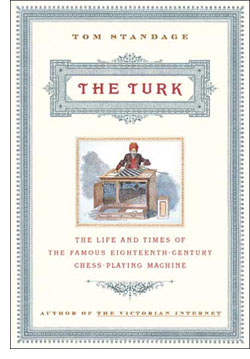 |
 |
 Tom Standage
Tom Standage
The Turk: The Life and Times of the Famous Eighteenth-Century Chess-Playing Machine
Walker Books
US Hardcover First Edition
ISBN 978-0-8027-1391-2
Publication Date: 04-01-2002
272 Pages; $24.00
Date Reviewed: 05-19-2002
Reviewed by: Rick Kleffel © 2002
Index:
Non-Fiction
Science Fiction
General Fiction
Mystery
True life situations that are stranger than fiction often end up getting turned into fiction. That's the case with the story of the Turk, an eighteenth-century clockwork machine that has been the subject of numerous novels and movies. But who needs fiction when the real story is so entertaining? In 'The Turk', Tom Standage recounts the journey of this important machine through the decades between its debut in 1769 and its demise in 1854.
Thought provoking even now, the Turk was an intellectual hand grenade when it first appeared, and the reverberations still ring out across our mindscape. Standage has done a fantastic job in his recreation of its life. It's a page-turning, pulse-pounding tale that reads like an elaborate steampunk fantasy. It's also likely to inspire another round of fictionalizations, but it's hard to imagine that anything could be more compelling, more entertaining, more interesting than the truth as written by Standage.
Standage starts with a brief history of 18th century 'automata', in itself quite fascinating. Any reader who enjoyed the 'toy shop scenes' in 'Blade Runner' will find its distant ancestors even more intriguing. In 1769, Hungarian nobleman and engineer Wolfgang von Kempelen was asked by Maria Theresa, Empress of Austria-Hungary to attend a magic show, so he could explain to her how the tricks worked. At the conclusion of the show, Kempelen said that he could make a device far more amazing than anything on display. Six months later, the Turk debuted.
The Turk was a life-sized figure of a man, carved from wood, who was seated behind a cabinet with two doors and bottom drawer. It was dressed in a fashionable "oriental" costume. Inside the cabinet, easily opened and viewed, was complex clockwork machinery. On top of the cabinet, In front of the Turk was a chessboard. It was wound up, set in motion and played immaculate chess, beating most opponents.
The implications of a chess-playing machine were immense. The reaction was incredible, and the Turk became a very popular attraction. Standage follows it throughout its history and its 85-year career. And he never misses out on the import of the very ideas the Turk suggested. Standage quotes David Brewster, a British popular scientist of the 1830's, who says, "'Those mechanical wonders which in one century enriched only the conjurer who used them, contributed in another to augment the wealth of the nation; and those automatic toys which once amused the vulgar, are now employed in extending the power and promoting the civilization of our species."'
The Turk inspired many creations as a result of its own unique technology, from Edgar Allen Poe's format for the detective story to Charles Babbage's Difference Engine. Finding out how this happened is part of the fun of this book. But Standage doesn't linger anywhere too long — he keeps his eye on the prize, which is the Turk itself. And yes, you do eventually find out how the Turk operated, thanks to copious notes kept by the owners and a recent reconstruction.
While this book is non-fiction it will have a great appeal to a wide range of genre fiction readers. The story itself has a very "steampunk" feel. In its lurid detail it almost reads like Tim Powers or James Blaylock. Readers who enjoyed 'Carter Beats the Devil' will find the engineering details of great interest, while the Turk's touring life was not that different from that of a stage magician. It also qualifies as a historical mystery, and readers of that genre who find the premise intriguing are also likely to enjoy this book.
As a matter of fact, this is simply one of the most enjoyable books I've come across in a long time. Where other non-fiction gets tedious, 'The Turk' is fleet. Where other non-fiction bogs down, 'The Turk' bucks up. It's nicely illustrated and laid out so it's easy to read, but the small format does make the book practically impossible to lay down. That's just as well — most readers won't want to put this book down until they're finished.
|
 |
|
|
 |
| |
Review Archive
All Reviews alphabetized by author.
General Fiction
Non-Genre, general fiction and literature.
Horror
Supernatural fiction, supernatural horror and non-supernatural horror.
Science Fiction
Science fiction, science fantasy, speculative fiction, alternate history.
Fantasy
Fantasy, surrealism and magic realism.
Mystery
Crime, thrillers, mystery, suspense.
Non-Fiction
Non-Fiction, True Crime, Forteana, Reference.
Poetry
|
|
 |
|




